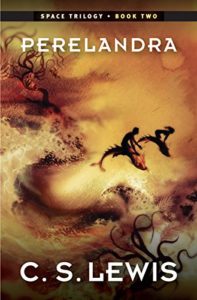
Author: C.S. Lewis
Publication Date: 1943
Also known as Voyage to Venus.
Official Summary: The second book continues the adventures of the extraordinary Dr. Ransom. Pitted against that greatest of human weaknesses, temptation, the great man must battle evil on a new world — Perelandra — when it is invaded by the Devil’s agent. Will Perelandra succumb to the Devil’s influence, or will it throw off the yoke of corruption and achieve a spiritual perfection as yet unknown to man? The outcome of Dr. Ransom’s mighty struggle will alone determine its fate.
Related Music
Introduction
Perelandra is the second novel in C.S. Lewis’s Space Trilogy, published in 1943. Building upon the cosmic setting introduced in Out of the Silent Planet, this story shifts to Venus (Perelandra), a new world in the earliest stages of its existence. Here, Lewis presents a profound retelling of the temptation of Eve, envisioning what might happen if a world could resist the fall into sin.
Filled with lush imagery, philosophical depth, and spiritual intensity, Perelandra is often considered the most poetic and beautiful of the trilogy.
Plot Summary
Dr. Elwin Ransom is sent to Perelandra by divine command (Maleldil) on a mission he does not fully understand. Upon arrival, he discovers a world covered mostly in floating islands, rich in vibrant, unspoiled life.
There, he meets the Green Lady, the Eve-like queen of Perelandra, who has been given one simple command: she must not dwell on the Fixed Land overnight. Soon, Ransom’s old enemy, Professor Weston, arrives, now possessed by a dark force.
Weston (or rather the “Un-Man” speaking through him) seeks to tempt the Green Lady into disobedience, echoing Satan’s temptation of Eve in Eden. Ransom realizes he must actively resist evil, not merely by persuasion, but by physical confrontation if necessary.
The story culminates in a cosmic battle between good and evil, as Ransom fights the Un-Man to protect Perelandra’s innocence. In the end, obedience triumphs, and Perelandra is saved from a fall, unlike Earth.
Major Characters
- Dr. Elwin Ransom – The hero, called to be a spiritual warrior and protector.
- The Green Lady – The new Eve of Perelandra, unfallen and filled with childlike wisdom.
- The Un-Man (Weston) – A vessel for demonic forces, attempting to bring ruin to Perelandra.
- Maleldil – The divine being, commanding and guiding Ransom throughout the story.
Themes
Temptation and Free Will
At the heart of Perelandra is a meditation on choice and obedience. Unlike the Eden story where Eve succumbs, Lewis imagines what would happen if temptation was resisted.
Goodness and Beauty
Perelandra is a sensory paradise, described in lush, vivid language. The world’s beauty mirrors its spiritual health, suggesting that goodness is not just moral but vibrantly alive and joyous.
The Necessity of Struggle
Ransom learns that spiritual evil cannot always be reasoned with—sometimes active resistance, even violent resistance, is necessary. His battle with the Un-Man is a symbol of the cost of preserving good.
Obedience as Freedom
Where earthly thinking often equates freedom with rebellion, Perelandra argues that true freedom comes from joyful obedience to divine will.
Connections to Narnia
- The struggle against temptation mirrors the inner battles characters like Edmund Pevensie face.
- The role of obedience echoes Lucy and Aslan’s relationship, where trust is key.
- Perelandra’s living landscape recalls the fresh, enchanted Narnia created in The Magician’s Nephew.
- Ransom’s mission foreshadows the missions of Aslan’s champions, sent into darkness with nothing but their faith.
Impact and Legacy
Perelandra is often regarded as C.S. Lewis’s most profound work of fiction. It explores deep theological and philosophical questions through thrilling narrative and transcendent imagery.
Its influence is seen in later Christian science fiction and fantasy, inspiring readers to contemplate obedience, temptation, and spiritual warfare not as abstract concepts but as living realities.
Conclusion
Perelandra is a masterpiece of cosmic storytelling, spiritual reflection, and lyrical beauty. For readers who cherish Narnia’s blend of moral depth and imaginative wonder, Perelandra offers an even deeper journey—one where the battle for a soul shapes the destiny of a world.
With Perelandra, Lewis invites readers into a radiant vision of what creation might have been—and what it still could be through trust, courage, and obedience to the good.

Be the first to comment